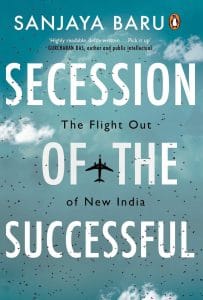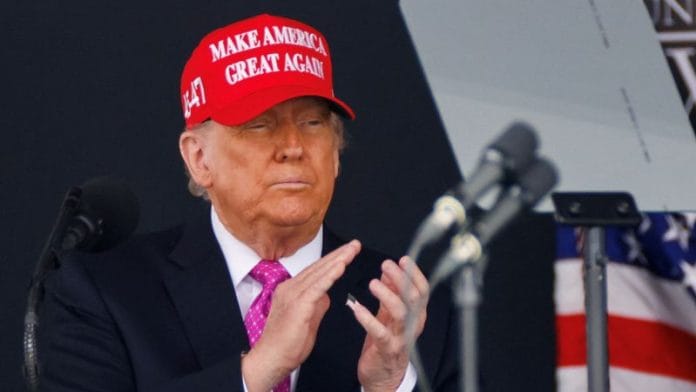Defending a liberal immigration policy, President Joe Biden told an election fundraising event in May 2024 that while ‘xenophobia’ and a lack of openness to immigrants was ‘hobbling’ the economic growth of countries like China, India and Japan, the US had, in fact, been a beneficiary of its openness to talented immigrants. ‘One of the reasons why our economy is growing is because of you and many others,’ Biden told a gathering of Asian Americans. ‘Why? Because we welcome immigrants.’
Addressing members of the Global Organization of People of Indian Origin-Connecticut Chapter (GOPIO-CT), US Congressman Jim Himes called Indian Americans ‘a secret weapon for economic growth…the future of US innovations’. ‘The brains of tech innovations are here… We have so much to do on immigration to enable this tech-savvy and entrepreneurial Indian American community to have a smoother and faster way to have Green Card and job visas.
Not to be left behind in attracting the Indian American vote, Donald Trump announced during his election campaign that an automatic route would be opened for green cards for bright young Indian immigrant graduates coming out of US colleges and intending to remain in the US. ‘What I want to do and what I will do is—you graduate from a college, I think you should get a Green Card automatically as part of your diploma, a Green Card to be able to stay in this country.’
Trump said he was sad to hear ‘stories where people graduated from a top college or from a college, and they desperately wanted to stay here, they had a plan for a company, a concept, and they can’t— they go back to India, they go back to China, they do the same basic company in those places’. Educated Asian immigrants, Trump was telling his voters, would also help Make America Great Again (MAGA)—his campaign slogan.
Having been re-elected on an anti-immigration platform, it remains to be seen how friendly he would remain towards legal Indian immigrants. In his first 100 days in office, Trump’s focus has been on illegal immigrants and tariffs. However, his administration has slowed down the grant of new H-1B visas and is reviewing policy with respect to the grant of a green card. There is growing anxiety about Trump’s immigration and citizenship policies, both among Indian Americans, NRIs and Indians aspiring for an American visa.
Also read: How upper caste Hindus imbibed every privilege of White corporate America
Indian Americans have contributed to US global leadership in a large number of fields, ranging from medicine and healthcare to information technology and finance. President Biden’s acknowledgement, however, was probably the most public and bold statement by a senior political leader. East and South Asian immigrants—Japanese, Koreans, Chinese and Indians—have powered the post-War dynamism of the US economy.
Chinese and Indian immigrants, who arrived on American coasts in their thousands over the past quarter of a century, have contributed handsomely to the continued global dominance of the US as a premier knowledge-based superpower. Much is often made of the US contribution to China’s and India’s rise. Surprisingly, few have tried to quantify the Asian contribution to the US’s global dominance as a technological power.
It is true that demographic shifts have hurt the growth prospects of many ageing developed economies. Biden was right to point to the economic cost imposed by the inward orientation of many developed economies. The US, however, has benefited not just from her openness to immigration but, in fact, and more so, by attracting highly talented immigrants, especially from Asia.
Gone are the days when the typical immigrant landing on the shores of Manhattan was a desperate European escaping poverty or war. Of course, many of the world’s impoverished, persecuted and desperate still enter the US. They too provide fuel to the engine of US growth and the comfort of the American lifestyle. However, it is the ‘best and brightest’ from Asia that illuminate the top of the pyramid of power and knowledge in the US.
The realization that innovation and the powering of the knowledge economy in the US requires a more liberal policy towards the immigration of Indian American talent has had to contend with the more familiar and generalized opposition to immigration. Responding to such opinion, Ignatius Chithelen published a study of Indian American contribution to business and innovation in the US, provocatively titled Passage from India to America: Billionaire Engineers, Extremist Politics and Advantage to Canada and China.
If President Trump restricts visas to Indians, Chithelen argued, there would be a flight of talent to Canada and in the end, China rather than the US would benefit. Chithelen pointed to the contribution that ‘billionaire engineers’ such as Satya Nadella, Sundar Pichai, Shantanu Narayen and several other CEOs and persons of eminence have made and continue to make to powering US business and the knowledge economy. Biden certainly got that message, but it remains to be seen if eventually Trump will too.
China and India have exported large numbers of highly educated professionals as well as skilled labour to the US over the past half a century. Their contribution to a wide range of fields, including computer science and information technology, basic and natural sciences, medicine, nuclear and space technology, finance and business, government and public affairs, has been considerable and highly visible.
In an aptly titled study published two decades ago, Give Us Your Best and Brightest: The Global Hunt for Talent and the Impact on the Developing World, Devesh Kapur and John McHale drew attention to this American search for talent from developing countries. A developed West was siphoning off talent from a developing South, their study warned, enabling the former to remain globally competitive and dominant. Better compensation, living and working conditions drew such human capital away from developing economies to the developed.
Post-war development economics did focus on the possibility of developed economies in fact continuing to benefit from their relations with developing countries even in the postcolonial era. Beginning with the early work of Hans Singer, Raul Prebisch and Celso Furtado in the 1950s, an entire body of literature emerged in the 1960s and 1970s that questioned the hypothesis that developing economies could benefit from foreign trade, investment and aid.
The Dependency School led by Andre Gunder Frank and Samir Amin and the World Systems school led by Emanuel Wallerstein went further to suggest that the ‘centre’ of the world economy, namely developed industrial economies, were, in fact, contributing to the ‘under-development’ of the ‘periphery’, while the periphery was feeding the continued global dominance of the centre.
Teresa Hayter’s classic expose of development aid showed how even aid money was not serving the goals of development but was, in fact, promoting the business interests of developed economies.8 This development economics literature viewed brain drain from developing to developed economies within this dependency framework. What few foresaw in the 1960s and 1970s was the role that developing country talent would play in the early twenty-first century by contributing to the technological progress of the world’s biggest economy through the continued augmentation of its ‘knowledge power’.
Surprisingly though, there is no significant study of this phenomenon despite the fact that many Indian professionals are based in US universities, institutions and think tanks. As many as 22,000 PIOs and NRIs are employed as full-time faculty across all US universities and sixteen Fortune 500 companies are headed by Indian Americans.
A 2024 report, put together by Indiaspora, an organization of Indian Americans, and the Boston Consulting Group (BCG), titled Small Community, Big Contributions, Boundless Horizons: The Indian Diaspora in the US merely skims the surface.
Even so, it presents some startling facts. A low-middle-income economy, that India is classified as by international financial institutions, has invested up to $40 billion in the world’s biggest economy since 2008, while total US FDI into India since 2000 has been estimated to be $64 billion. The irony underlying these numbers seems lost on the authors of the report. For if these numbers are correct, it could be claimed that on a per capita national income basis, a less developed India invests more in a developed US, than the other way round.
 This excerpt from Sanjaya Baru’s ‘Secession of the Successful: The Flight Out of New India’ has been published with permission from Penguin Random House India.
This excerpt from Sanjaya Baru’s ‘Secession of the Successful: The Flight Out of New India’ has been published with permission from Penguin Random House India.






